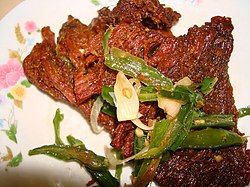 Dendeng batokok | |
| Course | Main course |
|---|---|
| Place of origin | Indonesia [1] |
| Region or state | West Sumatra |
| Created by | Minangkabau |
| Serving temperature | Hot or room temperature |
| Main ingredients | Meat, spices |
Dendeng is thinly sliced dried meat in Minangkabau cuisine. [1] It is preserved through a mixture of sugar and spices and dried via a frying process. [2] It is similar to jerky. Dendeng is traditionally produced by using some spices and sugar at various levels. Therefore, its flavour is sweet and spicy. It is also stable for several weeks at room temperature. [1]
Contents
The creation of dendeng is commonly credited to the Minangkabau people, in which their earliest dendeng was made from dried beef, so that it would be preserved for days and could be taken along with them when they traveled. The Padang cuisine version—probably the most popular dendeng dish in Indonesia—is called dendeng balado or dendeng batokok. It is a specialty from Padang, West Sumatra and is made from thinly cut beef which is dried and fried before adding chillies and other ingredients. [3]